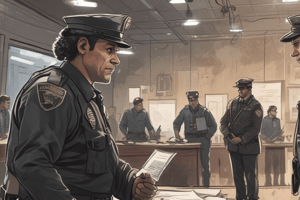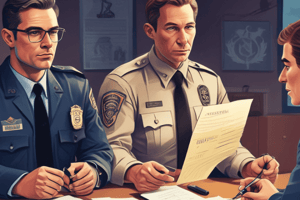Podcast
Questions and Answers
What is a significant consequence of poor intercultural communication?
What is a significant consequence of poor intercultural communication?
- Miscommunication and division between cultures (correct)
- Enhanced understanding between individuals
- Promotion of cultural engagement and exchanges
- Increased collaboration among diverse groups
Which behavior exemplifies being culturally responsive?
Which behavior exemplifies being culturally responsive?
- Ignoring cultural differences during interactions
- Avoiding discussions about cultural backgrounds
- Enforcing one's cultural norms on others
- Demonstrating openness to learn about other cultures (correct)
How can establishing rapport impact intercultural communication?
How can establishing rapport impact intercultural communication?
- It complicates business transactions.
- It has no effect on communication outcomes.
- It is irrelevant in most cultural contexts.
- It can lead to more informative exchanges. (correct)
Which phrase should be avoided to prevent establishing a separation with others?
Which phrase should be avoided to prevent establishing a separation with others?
What is an important aspect of demonstrating respect for different cultures?
What is an important aspect of demonstrating respect for different cultures?
What aspect of professionalism is highlighted by knowing your job and being competent?
What aspect of professionalism is highlighted by knowing your job and being competent?
What should one do if a community member points out a cultural mistake?
What should one do if a community member points out a cultural mistake?
Which action exemplifies good professionalism when mistakes are made?
Which action exemplifies good professionalism when mistakes are made?
Why is understanding diverse perspectives important in intercultural communication?
Why is understanding diverse perspectives important in intercultural communication?
Which of the following actions contributes to effective intercultural communication?
Which of the following actions contributes to effective intercultural communication?
How can an officer maintain a professional demeanor during interactions?
How can an officer maintain a professional demeanor during interactions?
Which of the following is NOT considered a characteristic of professionalism?
Which of the following is NOT considered a characteristic of professionalism?
What is the LEED framework designed to support in professional interactions?
What is the LEED framework designed to support in professional interactions?
Which non-verbal tool is considered an officer's most valuable asset?
Which non-verbal tool is considered an officer's most valuable asset?
Why is maintaining a positive attitude important in a professional setting?
Why is maintaining a positive attitude important in a professional setting?
What is the consequence of ignoring someone's boundaries in physical touch?
What is the consequence of ignoring someone's boundaries in physical touch?
Which factor is NOT mentioned as affecting eye contact?
Which factor is NOT mentioned as affecting eye contact?
What does mutual gaze signify in a conversation?
What does mutual gaze signify in a conversation?
What can a break of gaze potentially indicate?
What can a break of gaze potentially indicate?
Why is personal space considered important in communication?
Why is personal space considered important in communication?
What might happen if someone does not maintain eye contact during a conversation?
What might happen if someone does not maintain eye contact during a conversation?
Which of the following is true regarding the smell aspect of communication?
Which of the following is true regarding the smell aspect of communication?
What is a likely effect of understanding eye contact in communication?
What is a likely effect of understanding eye contact in communication?
In the context of communication, what does the term 'break of gaze' imply?
In the context of communication, what does the term 'break of gaze' imply?
How can personal space influence communication effectiveness?
How can personal space influence communication effectiveness?
What is one of the first steps that should be taken in conflict resolution?
What is one of the first steps that should be taken in conflict resolution?
What is a key goal when managing a conflict?
What is a key goal when managing a conflict?
In addition to de-escalation, which of the following actions might be necessary?
In addition to de-escalation, which of the following actions might be necessary?
How should an officer explain their actions during conflict resolution?
How should an officer explain their actions during conflict resolution?
What may indicate that enforcement action, such as making an arrest, is necessary?
What may indicate that enforcement action, such as making an arrest, is necessary?
What does the term 'de-escalation techniques' refer to?
What does the term 'de-escalation techniques' refer to?
What is critical to remember when handling potentially violent situations?
What is critical to remember when handling potentially violent situations?
Which strategy is NOT recommended for conflict resolution?
Which strategy is NOT recommended for conflict resolution?
When determining the next steps in a conflict management situation, what should be assessed?
When determining the next steps in a conflict management situation, what should be assessed?
Why is it important to gather information from all sides involved in a conflict?
Why is it important to gather information from all sides involved in a conflict?
What can destroy goodwill between law enforcement and the community?
What can destroy goodwill between law enforcement and the community?
What factor should be considered regarding communication effectiveness in diverse communities?
What factor should be considered regarding communication effectiveness in diverse communities?
What might affect communication between an officer and community members?
What might affect communication between an officer and community members?
In what way can an officer gain cooperation from the community?
In what way can an officer gain cooperation from the community?
What common misconception about law enforcement might affect community perceptions?
What common misconception about law enforcement might affect community perceptions?
What essential piece of knowledge can help improve officer-community interactions?
What essential piece of knowledge can help improve officer-community interactions?
Which aspect of communication is significantly affected by non-verbal cues?
Which aspect of communication is significantly affected by non-verbal cues?
What is a common complaint communities have about law enforcement officers?
What is a common complaint communities have about law enforcement officers?
How can personal space influence communication with diverse communities?
How can personal space influence communication with diverse communities?
What should officers do to enhance their communication skills in a multicultural environment?
What should officers do to enhance their communication skills in a multicultural environment?
Flashcards
Avoiding Unprofessional Language
Avoiding Unprofessional Language
Using phrases like "obviously" or "you people" can create distance and disrespect. Instead, focus on explaining clearly and respectfully.
Redirecting Unrealistic Requests
Redirecting Unrealistic Requests
When someone asks for something unrealistic, focus on what can be done instead of what can't be done. Explain your actions and reasoning.
Professional Demeanor
Professional Demeanor
A professional attitude helps you respond appropriately to situations and can make the public more likely to be cooperative.
What is Professionalism?
What is Professionalism?
Signup and view all the flashcards
Command Presence
Command Presence
Signup and view all the flashcards
Improving Command Presence
Improving Command Presence
Signup and view all the flashcards
LEED Framework
LEED Framework
Signup and view all the flashcards
The Importance of Attitude
The Importance of Attitude
Signup and view all the flashcards
De-escalation Techniques
De-escalation Techniques
Signup and view all the flashcards
Conflict Resolution
Conflict Resolution
Signup and view all the flashcards
Separating People in Conflict
Separating People in Conflict
Signup and view all the flashcards
Establishing Control
Establishing Control
Signup and view all the flashcards
Communicate Clearly and Respectfully
Communicate Clearly and Respectfully
Signup and view all the flashcards
Providing Resources
Providing Resources
Signup and view all the flashcards
Mediating a Compromise
Mediating a Compromise
Signup and view all the flashcards
Transparency and Dignity
Transparency and Dignity
Signup and view all the flashcards
Resolving vs. Managing Conflict
Resolving vs. Managing Conflict
Signup and view all the flashcards
Enforcement Action
Enforcement Action
Signup and view all the flashcards
Mutual Gaze
Mutual Gaze
Signup and view all the flashcards
Break of Gaze
Break of Gaze
Signup and view all the flashcards
Smell and Communication
Smell and Communication
Signup and view all the flashcards
Personal Space in Communication
Personal Space in Communication
Signup and view all the flashcards
Eye Contact Importance
Eye Contact Importance
Signup and view all the flashcards
Touch and Communication
Touch and Communication
Signup and view all the flashcards
Importance of Verbal and Nonverbal Communication
Importance of Verbal and Nonverbal Communication
Signup and view all the flashcards
Interpreting Break of Gaze
Interpreting Break of Gaze
Signup and view all the flashcards
Mutual Gaze to Encourage
Mutual Gaze to Encourage
Signup and view all the flashcards
Mindful Nonverbal Communication
Mindful Nonverbal Communication
Signup and view all the flashcards
Intercultural Communication
Intercultural Communication
Signup and view all the flashcards
Culturally Responsive
Culturally Responsive
Signup and view all the flashcards
Learning About Your Community
Learning About Your Community
Signup and view all the flashcards
Demonstrating Respect for Cultures
Demonstrating Respect for Cultures
Signup and view all the flashcards
Being Open to Learning and Fixing Mistakes
Being Open to Learning and Fixing Mistakes
Signup and view all the flashcards
Everyone Has Different Experiences
Everyone Has Different Experiences
Signup and view all the flashcards
Talking to Community Members
Talking to Community Members
Signup and view all the flashcards
What is culture?
What is culture?
Signup and view all the flashcards
What is intercultural communication?
What is intercultural communication?
Signup and view all the flashcards
Why might people have negative views of law enforcement?
Why might people have negative views of law enforcement?
Signup and view all the flashcards
What does it mean to be professional in law enforcement?
What does it mean to be professional in law enforcement?
Signup and view all the flashcards
What behaviors damage public trust in law enforcement?
What behaviors damage public trust in law enforcement?
Signup and view all the flashcards
How does understanding your community improve communication?
How does understanding your community improve communication?
Signup and view all the flashcards
How can officers improve communication in diverse communities?
How can officers improve communication in diverse communities?
Signup and view all the flashcards
Why is it important to identify differences and similarities in communication?
Why is it important to identify differences and similarities in communication?
Signup and view all the flashcards
How do cultural factors impact effective law enforcement communication?
How do cultural factors impact effective law enforcement communication?
Signup and view all the flashcards
How can you foster cooperation and build trust?
How can you foster cooperation and build trust?
Signup and view all the flashcards
Study Notes
Unit 1: Fundamentals of Communication
- Lesson Goal: At the end of the lesson, students will be able to communicate effectively using empathy, courtesy, and professionalism.
Unit 1: Lesson 1: Communication Basics
- Think About This: A resident approaches an officer, angry about rising burglaries and demanding more police action. How can the officer effectively de-escalate the situation?
- Law Enforcement Officer Communication Skills: Effective communication is crucial for law enforcement officers to work safely and effectively. Officers should adapt their communication style to fit the needs and concerns of individuals from various backgrounds, to help avoid escalating crises.
- Communication Methods: Communication involves verbal and non-verbal exchanges: spoken/written words, gestures, facial expressions, and body language.
- Effective Communication: (diagram of effective communication process) Effective communication involves sending clear messages and ensuring the listener understands those messages.
- Empathy: Empathy is a key communication skill, enabling officers to understand and care about the emotions of others. It is not sympathy.
- Courtesy: Demonstrating professionalism and respect to others. Examples include introducing yourself by name, treating people with dignity and respect, and avoiding insensitive language or tone in interacting with others.
Unit 1: Lesson 2: Verbal and Non-verbal Communication
- Lesson Goal: To interpret verbal and non-verbal communication, considering context.
- Verbal and Non-verbal Cues: Understanding diverse communication cues is important (tone, volume, pitch, words, appearance, posture, gestures, eye contact, facial expressions, etc).
- Voice and Tone: Pay attention to verbal tone, volume, and pitch to determine if someone is conveying sarcasm, confidence, compassion, or anger.
- General Appearance and Dress: Judgments are made based on appearance; maintaining objectivity in these judgments is necessary.
- Posture: Awareness of posture can reveal additional insights about the situation (body language, maintaining eye contact, and shifting posture).
Unit 1: Lesson 3: Conflict Resolution and De-escalation
- Lesson Goal: To understand communication barriers and how to use conflict resolution and de-escalation skills.
- Challenges to Effective Communication: Several communications barriers (failing to listen, using improper language and tone, implicit bias, prejudice) impact successful communication in any setting.
- Managing Conflict: Officers should mediate or resolve conflicts as soon as they appear, guiding involved parties toward peaceful resolutions through appropriate mediation techniques, understanding cultural differences, and applying procedural justice principles.
- Conflict Resolution Strategies: Strategies include separating people, gathering information, clarifying actions, providing options, finding compromise, justifying actions, and maintaining dignity.
Unit 2: Professional Communication
- Lesson 1: Knowing Your Community and Interacting with the Public
- Lesson Goal: To learn how to interact fairly and professionally with a diverse community.
- Community Expectations: The community expects law enforcement officers to be courteous, efficient, and accessible and to treat all people fairly and compassionately. An officer's unprofessional behavior can negatively impact the community's perception of law enforcement.
- Community Demographics and Officer Response: Officers need to understand diversity in communities (socioeconomic backgrounds, ages, disabilities, religious beliefs, etc)
- Cultural Sensitivity: Importance of cultural awareness and sensitivity.
Unit 2: Lesson 2: Core Communication Competencies
-
Lesson Goal: To understand self-talk, self-awareness, and core communication competencies in serving the community.
-
Self-Talk and Self-Awareness: Preparing for interactions and managing emotions to avoid bias and promote professionalism. Use self-control to address emotional triggers or stressful situations effectively.
-
Nonverbal Communication: Importance of nonverbal cues for effective communication and how they can affect interpersonal interactions.
-
Environment and Audience Considerations: Understanding that environments and cultural considerations affect the nature of responses.
-
Implicit Bias, Self-Awareness: The importance of recognizing and responding to implicit bias when communicating
-
Procedural Justice: Applying procedural justice principles in community interactions.
Studying That Suits You
Use AI to generate personalized quizzes and flashcards to suit your learning preferences.




